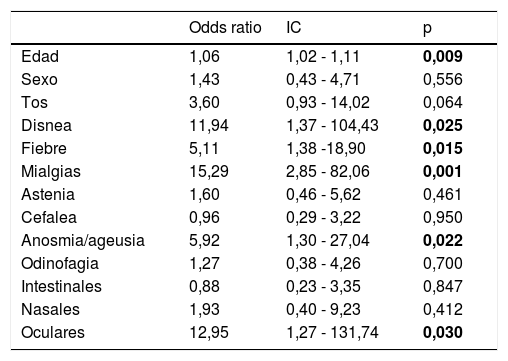La infección por covid-19 requiere un diagnóstico temprano, siendo la PCR la prueba gold estándar. Los protocolos propugnan el uso de pruebas antigénicas rápidas que precisan de evaluación en la práctica clínica real. El objetivo fue evaluar la prueba diagnóstica de detección rápida de antígeno, Panbio Covid rapid test, comparada con la PCR, en los pacientes con clínica de 5 o menos días de evolución y con alta sospecha de infección por covid-19 en un centro de salud.
Materiales y métodosUn total de 103 pacientes mayores de 14 años que acudieron a un centro de salud urbano ubicado en el Distrito de Usera de Madrid, con alta sospecha de infección por covid-19, en los primeros 5 días de evolución desde el inicio de los síntomas durante el mes de noviembre de 2020. Como intervenciones se realizan las pruebas diagnósticas de covid-19: antígeno y PCR.
ResultadosLa prevalencia de la enfermedad fue del 24,3% según la prueba PCR y del 17,5% según el test antigénico rápido. La sensibilidad fue del 72% (IC al 95%: 54,3-89,6%). La especificidad fue del 100%.
Los valores predictivos positivo y negativo fueron del 100% y del 91,8%, respectivamente. En el análisis bivariante, no hubo relación entre los síntomas y la presencia de enfermedad, excepto para las mialgias (p=0,030). En el análisis multivariado se encontró relación entre la tos, la disnea, la fiebre, las mialgias, la anosmia/ageusia y los síntomas oculares y la presencia de enfermedad.
ConclusionesLa sensibilidad y la especificidad para el test de antígeno rápido Panbio son similares a otros estudios realizados en atención primaria. En prevalencia alta de enfermedad y con síntomas de alta sospecha, los resultados positivos del test se pueden considerar definitivos, pero los resultados negativos requerirán confirmación. Las mialgias, la fiebre, la disnea, la anosmia/ageusia y los síntomas oculares se pueden relacionar más con la presencia de covid-19.
COVID-19 infection requires early diagnosis, with PCR being the gold standard test. The protocols advocate the use of rapid antigenic tests that require evaluation in actual clinical practice. The objective was to evaluate the diagnostic test for rapid antigen detection, Panbio Covid rapid test, compared with PCR, in patients with symptoms of 5 or less days of evolution and with a high-suspicion of infection by COVID-19 in a health center.
Materials and methods103 patients over 14 years of age who attended an urban health center located in the Usera District of Madrid, with high-suspicion of COVID-19 infection, in the first 5 days of evolution from the onset of symptoms during the month of November 2020. Interventions: diagnostic tests for COVID-19 are performed: antigen and PCR.
ResultsThe prevalence of the disease was 24.3% according to the PCR test and 17.5% according to the rapid antigenic test. The sensitivity was 72% (95% CI: 54.3–89.6%). The specificity was 100%. The positive and negative predictive values were 100% and 91.8% respectively. In the bivariate analysis, there was no relationship between symptoms and the presence of disease, except for myalgias (p=0.030). The multivariate analysis found a relationship between cough, dyspnea, fever, myalgia, anosmia/ageusia, and ocular symptoms and the presence of disease.
ConclusionsThe sensitivity and specificity for the Panbio rapid antigen test are similar to other studies performed in primary care. In high-prevalence of disease and with highly suspected symptoms, positive test results can be considered definitive, but negative results will require confirmation. Myalgia, fever, dyspnea, anosmia/ageusia, and ocular symptoms may be more related to the presence of COVID-19.
Artículo
Diríjase al área privada de socios de la web de la SEMERGEN, (https://www.semergen.es/index.php?seccion=biblioteca&subSeccion=revistaSEMERGEN ) y autentifíquese.
Comprando el artículo el PDF del mismo podrá ser descargado
Precio 19,34 €
Comprar ahora












